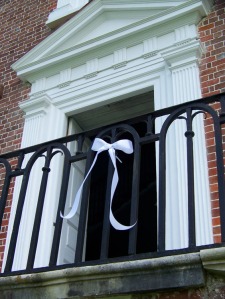Voted the Best Place to See by Condé Nast Traveler.


As a tribute to Philip Simmons, white ribbons adorn the ironwork he helped to shape.
This past week, the country lost one of its national treasures when Mr. Philip Simmons, the famed Charleston blacksmith, passed away. Mr. Simmons’ work has been documented and appreciated for years, and the ironwork he created, including gates, grills, panels, and railings, are now appreciated as cultural and artistic icons.
While his works are seen throughout downtown Charleston, in places both private and prominent, few people know that Mr. Simmons was also a preservationist, lending his expertise and talent to the centuries-old ironwork of Drayton Hall.
In the mid-1980s, Mr. Simmons was asked to help repair the iron railings on the land and riverfront steps during a stabilization effort of the stone steps and landings. He repaired and even in some places, replaced, sections of the railing. But that work was not his first encounter with Drayton Hall.

As a young man, he knew many of the African Americans that then lived at Drayton Hall, including Richmond Bowens, who he recalled as a close friend. After Drayton Hall opened as historic site, and Richmond Bowens worked as the gatekeeper, Mr. Simmons would sometimes drive out to the site, to see and talk with Mr. Bowens, and reflect on the times and people they knew.
More information on Philip Simmons, his life, and his work can be found at The Philip Simmons Foundation and in recent articles in the Charleston’s Post & Courier newspaper.